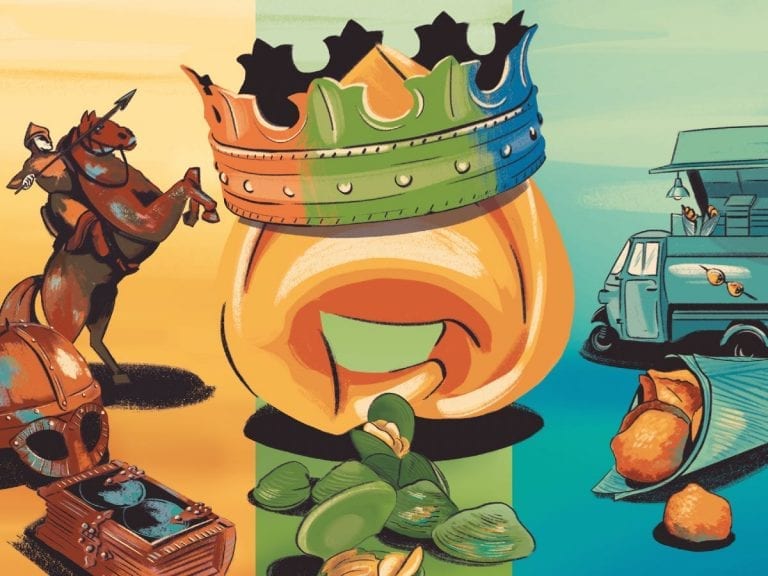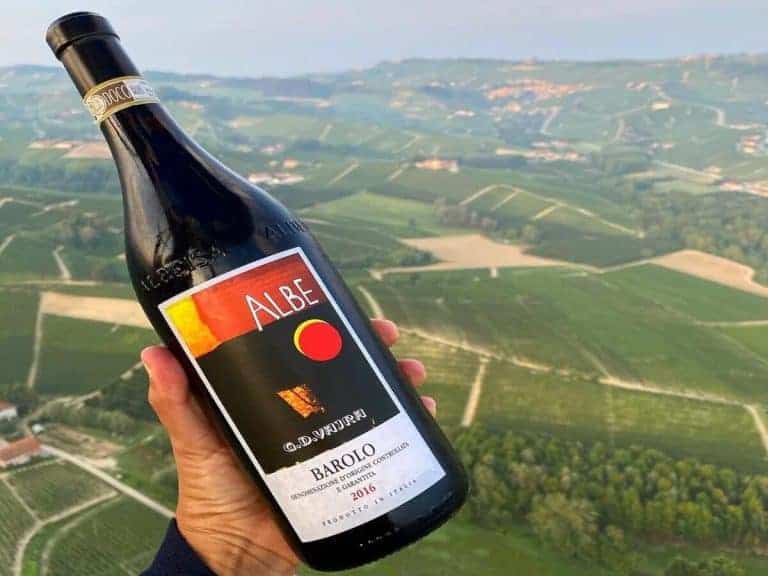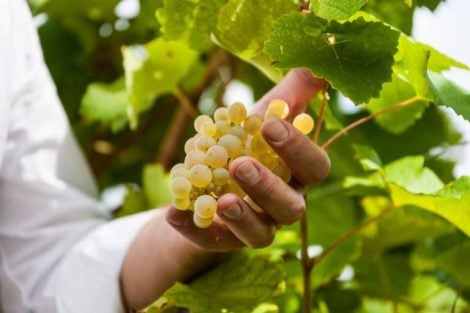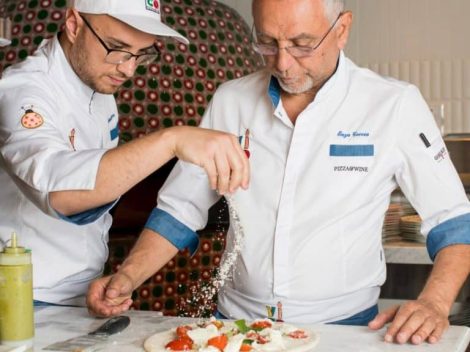The recipe acquires greater strength from the comparison between different cultures and sensibilities and aims to conquer a future beyond the past. In the April issue of the Gambero Rosso monthly magazine we compared the opinions of chefs, dividing them between purists and innovators.
The first long shelf-life tortellini
“Plin Plin Tortellin… / With six chicken eggs / in a kilo of flour, / grana prosciuttini meat / here are the real tortellini. / They are good, there are many: / Fioravanti tortellini.” It was the early 1960s, the Piedmontese dry pasta company patented its long shelf-life tortellini and began producing them in the Bolognese laboratory of San Lazzaro. These are the years in which tortellini began to emerge from the tradition of family recipe books and then landed on the "original recipe" (but whose? No one knows!) deposited at the Bologna Chamber of Commerce by the Tortellini Guild. And already in the nursery rhyme that raged on TV commericals at the time, the industrial "recipe" was very different from the traditional one: there are 6 eggs for a kilo of flour, while the traditional pasta dough was rolled - also according to the Guild recipe - with 10 eggs per kilo. And then there was Grana where the traditional recipe calls for Parmigiano Reggiano.
From family cookbooks to industry
But it is precisely in this postwar period and the economic boom, that tortellini truly became a national dish that is prepared in all homes across Italy. Maybe just bought in bags and drowned in a nice broth. Of course made with a bouillon cube! So much for tradition and purism. Yet, just ten years after the birth of the modern industrial tortellini, the Tortellini Guild feels the need to crystallise the recipe by fixing its purity, but also by interrupting an evolution that started from the Middle Ages and that has matured over the centuries through stories and family recipe books of a beautiful portion of Italy ranging from Emilia Romagna to southern Piedmont, passing through a strip of Lombardy to areas of the Veneto down to Pesaro. A story that is not as linear and crystalline as the recipe would suggest. And which, above all, does not take into account how tortellini (and their cousins from Romagna: cappelletti) have actually evolved and have been the protagonists, in recent decades, of a long series of challenges. Comparisons, innovations and events in which alongside the traditional versions there were new experiments involving stuffing, dough and condiments.
The eternal dispute: tradition versus innovation
So, before talking a little about the history and mythology of tortellini (which means small cakes, with the history of the various ravioli and stuffed pastas of the Renaissance) we give the floor to a chef born in Bari but for years now in Bologna. He has been one of the promoters of the Tour-tlen association in which tortellini refers to both the importance of travel and of tradition. “I strongly believe that to save tradition we must innovate - says Mario Ferrara, chef and owner of the Bolognese trattoria Scaccomatto - The classic, in broth, remains central and unbeatable, but I don't see why we shouldn't look for anything else. I make one with traditional filling, with classic rolling pin dough, dipped in a cream of broth and Parmigiano, flavoured with lemongrass. But over time we have made different tortellini also with different fillings, maybe even vegetable ones. This field of research and innovation is the only way to keep tradition important and alive. The diversity that comes out in the association's events in Bologna creates interest and debate without ever touching the 'Tortellino king in broth.' I am a man of the South even though I have lived in Bologna for a very long time, and I believe that cross-pollination is a wealth and a moment of growth, not an impoverishment.”
The navel of Venus amid Guelphs and Ghibellines
Probably, the idea of tortellini was born (as often the dishes of ancient and rooted family tradition do) as a way of recycling leftover roasts from the tables of the few noblemen who could afford luxury foods. The Bolognese historian Alessandro Cervellati in the early 1900s traces the use of tortellini in broth in Bologna back to the 12th century. Full-fledged Middle Ages. Moreover, documented traces are also found in a parchment of 1112 and in a papal bull of Alexander III of 1169 (even if it's a hoax: the manuscript refers to a Parisian correspondence, but the common vernacular mistook it as legit). It's however in an anonymous manuscript dated between the end of the 14th and the beginning of the 15th century that the true progenitors of today's tortellini come to light: the torteleti di enula (the essayist and historian of Bolognese gastronomy Luca Cesari made and cooked them some time ago) in which the filling was beef combined with minced elecampane.
And again: an anonymous recipe book in vernacular dates back to the second half of the 1300s, describing tortelli di bronza, or pork loin. “Remove the bronza, boil it, beat it and mix together fresh cheese, a few eggs, and strong spices. Fill tortelli with the mixture, cook them in capon or whatever broth, and add cheese and pepper in the bowls.” Finally, at the height of the Renaissance, the humanist cook Bartolomeo Scappi describes the "torteletti" that the common people call "annolini." Thus we arrive at the 17th century with tortellini dressed with melted butter from the agronomist Vincenzo Tanara and a recipe that is much less sophisticated and very different from the one recorded as "traditional," described by the French bibliographer Valéry Pasquin: with "a filling of ground beef tallow, egg yolks and Parmesan."
Ancestors aside, it was in 1908 that Giuseppe Ceri, with the moniker "Ombelico di Venere," created the myth of the origin of tortellini, taking as a cue the classic rivalry between Bologna and Modena on the birthright and referring to a fact of the medieval era taken up as the parody of a poem from the 17th century that narractes the incident ('La secchia rapita' by Alessandro Tassoni) and which was also later set to music with libretto by Gastone Boccherini and notes by Antonio Salieri, in 1772. We thus go back to the battle of Zappolino in which Guelphs (mostly Bolognese and boasting a large army) and Ghibellines (especially from Modena and pursued because accused of stealing a bucket) faced off in the open field. Pending the battle, the gods linked to the Modenese (including Venus) rested at an inn in Castelfranco Emilia. In the morning, the innkeeper (who was of Bolognese origin) peered through the keyhole and saw Venus naked. Struck by the grace of her navel he immediately immortalised the beauty of the shapes, giving birth to tortellini. "To imitate that navel with pasta / It flashed in his head ... In the kitchen he descended / And from a fresh dough... A small and round piece he took off / Which he then wrapped on his finger / In a thousand and a thousand shapes / Trying to imitate / That divine and singular navel..." So Ceri resumed the disputes between Modenese and Bolognese on tortellini and also resolved them, citing Castelfranco––back then Bolognese and on the border––and Venus who was pro-Modena but the host who was from Bologna... Today, just to increase the rivalry and the respective paternity claims, Castelfranco is firmly in the province of Modena. In short, the stories are not lacking.
From historical disputes to the supply chain of ingredients
In reality, over the centuries, each area has developed its own typical variations (an example is cappelletti from Romagna that have perhaps maintained greater freedom of expression) and each family has handed down recipes from mother to daughter, from grandmother to granddaughter. "With the municipality of Bologna - explains Carlo Alberto Borsarini, President of the Tour-tlen association and chef-owner of La Lumira in Castelfranco Emilia - we have been studying for some time the creation of a Deco nomenclature certifying the origin of the raw materials used to make our tortellini. In the eternal dispute over the areas and diversity of tortellini, we want to begin to guarantee the local origin of the products used: only in this way can the diversification of the areas make any sense. For the past 20 years we have been discussing whether the one from Bologna or Reggio is better, but in reality tortellini are often all made with the same ingredients bought at the same distributors!"
Thus, in his ten-year tests on "turtlen," Borsarini encountered a great study on the broth, "which is 50% of the tortellini" he smiled. The search led to the "sustainable broth." "The goal was for it to look like chicken broth, but in reality it was not of animal origin. Because, farming ethics are fine, but in the end, to make a broth you still have to use good pieces of meat and I don't find it very sustainable. So - said the chef - I tried to make a quality broth using Parmigiano rinds, macis and burnt leek: all skins, scraps and therefore with zero impact and in any case tasty."
The ethics of tradition according to Bottura
Massimo Bottura from Modena is certainly not a traditionalist. Yet, he has no doubts about tortellini. "I believe that the modernity of tortellini today is above all in the ethical dimension in which the knowledge of an ancient culture is transmitted to young people, even disadvantaged ones, of a symbol of our roots. In this sense - affirms Bottura - I deeply believe that the advanced point of the modernity of tortellini is precisely in the work of the Il Tortellante association. And then, of course, in the ethics of the raw materials employed. Using meats and Parmigiano from small artisans and from ethical and sustainable farms and crops is what can make the difference, even towards the future: a future in which these producers who take on the responsibility of not destroying, rather supporting the environment and the ecosystem, occupy greater space." Yet, Bottura launched some provocations... Just before the year 2000, while the volcanic Giovanni Rana was beginning to flood Italian kitchens with TV commercials and "new generation" tortellini and cappelletti, more or less creative, he invented “tortellini that walk on broth.” In which the broth becomes solid thanks to thickeners. "It was a provocation, of course - explained Massimo - but it was the way to bring people who were no longer able to recognize them closer to traditional flavours, after 40 years of industrial and flattened gastronomy. There are tales of grandmother's "turtlen," but then only those produced by industry are actually familiar flavours." And that provocation aroused arrows from purists and excommunications from traditional integralists. "They wrote in the newspapers that to avoid coming to eat at my Osteria Francescana - smiles Bottura - However, after that didactic type test, I instead looked for a way that was of true enjoyment and so now I offer my tortellini in bianco, but not with cream: I serve them with a 36-month Parmigiano Reggiano cream dissolved in water. In the end I chose an almost historical compromise."
by Stefano Polacchi
illustrations by Daniela Bracco


 Non-alcoholic wines? Call them what you want, but they’re still a derivative of wine.” An Interview with Martin Foradori
Non-alcoholic wines? Call them what you want, but they’re still a derivative of wine.” An Interview with Martin Foradori The 8 best Trentodoc wines chosen by Gambero Rosso
The 8 best Trentodoc wines chosen by Gambero Rosso A Piedmont wine enters the top ten of Wine Spectator's "Top 100"
A Piedmont wine enters the top ten of Wine Spectator's "Top 100" Sparkling wines surpass still wines in Italian out-of-home consumption. Most popular during the aperitif
Sparkling wines surpass still wines in Italian out-of-home consumption. Most popular during the aperitif American Barbecue wins a Michelin star for the first time in history
American Barbecue wins a Michelin star for the first time in history






